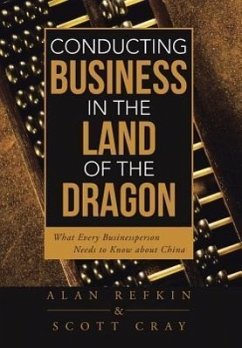- Broschiertes Buch
- Merkliste
- Auf die Merkliste
- Bewerten Bewerten
- Teilen
- Produkt teilen
- Produkterinnerung
- Produkterinnerung
With the rise of the Chinese economy and consumer market, intellectual property (IP) conflicts in Sino-U.S. business transactions are increasing, and consequently, companies are intent on achieving maximum IP values in China-related cross-border transactions. Conducting Business in China: An Intellectual Property Perspective provides readers with the necessary guidance on conducting business in China from an intellectual property perspective, offering specific advice on how to profitably leverage technology and IP assets while minimizing potential risk for companies and their Chinese counterparts.…mehr
Andere Kunden interessierten sich auch für
![Conducting Business in the Land of the Dragon Conducting Business in the Land of the Dragon]() Alan RefkinConducting Business in the Land of the Dragon29,99 €
Alan RefkinConducting Business in the Land of the Dragon29,99 €![International Trade Policies and Climate Change Governance International Trade Policies and Climate Change Governance]() P.K. RaoInternational Trade Policies and Climate Change Governance41,99 €
P.K. RaoInternational Trade Policies and Climate Change Governance41,99 €![The Role of Biotechnology in Countering BTW Agents The Role of Biotechnology in Countering BTW Agents]() KelleThe Role of Biotechnology in Countering BTW Agents41,99 €
KelleThe Role of Biotechnology in Countering BTW Agents41,99 €![The World Trade Organization The World Trade Organization]() Patrick F. J. Macrory (Volume ed.) / Arthur E. Appleton / Michael G. PlummerThe World Trade Organization403,99 €
Patrick F. J. Macrory (Volume ed.) / Arthur E. Appleton / Michael G. PlummerThe World Trade Organization403,99 €![Origin Management Origin Management]() Anne van de HeetkampOrigin Management81,99 €
Anne van de HeetkampOrigin Management81,99 €![Managing Chinese-African Business Interactions Managing Chinese-African Business Interactions]() Managing Chinese-African Business Interactions81,99 €
Managing Chinese-African Business Interactions81,99 €![China's Management Revolution China's Management Revolution]() Charles-Edouard BouéeChina's Management Revolution61,99 €
Charles-Edouard BouéeChina's Management Revolution61,99 €-
-
-
With the rise of the Chinese economy and consumer market, intellectual property (IP) conflicts in Sino-U.S. business transactions are increasing, and consequently, companies are intent on achieving maximum IP values in China-related cross-border transactions.
Conducting Business in China: An Intellectual Property Perspective provides readers with the necessary guidance on conducting business in China from an intellectual property perspective, offering specific advice on how to profitably leverage technology and IP assets while minimizing potential risk for companies and their Chinese counterparts.
Hinweis: Dieser Artikel kann nur an eine deutsche Lieferadresse ausgeliefert werden.
Conducting Business in China: An Intellectual Property Perspective provides readers with the necessary guidance on conducting business in China from an intellectual property perspective, offering specific advice on how to profitably leverage technology and IP assets while minimizing potential risk for companies and their Chinese counterparts.
Hinweis: Dieser Artikel kann nur an eine deutsche Lieferadresse ausgeliefert werden.
Produktdetails
- Produktdetails
- Verlag: OUP USA / Oxford University Press
- Seitenzahl: 298
- Erscheinungstermin: 1. Oktober 2012
- Englisch
- Abmessung: 234mm x 156mm x 16mm
- Gewicht: 454g
- ISBN-13: 9780199760220
- ISBN-10: 0199760225
- Artikelnr.: 35709639
- Herstellerkennzeichnung
- Libri GmbH
- Europaallee 1
- 36244 Bad Hersfeld
- gpsr@libri.de
- Verlag: OUP USA / Oxford University Press
- Seitenzahl: 298
- Erscheinungstermin: 1. Oktober 2012
- Englisch
- Abmessung: 234mm x 156mm x 16mm
- Gewicht: 454g
- ISBN-13: 9780199760220
- ISBN-10: 0199760225
- Artikelnr.: 35709639
- Herstellerkennzeichnung
- Libri GmbH
- Europaallee 1
- 36244 Bad Hersfeld
- gpsr@libri.de
Lei Mei is the managing partner of Mei & Mark LLP, a Washington, DC based intellectual property and litigation law firm. A Chinese native and graduate of Duke University Law School, Mr. Mei counsels large and emerging companies in the U.S. and China regarding IP issues and strategies, drawing from his unique experience in business, technology, and law.
Acknowledgements
Introduction
Chapter 1 IP Practice in the New Global Economy
Chapter 2 China's IP System and Trade Regulations
I. Introduction
II. Rise of the Chinese Economy
III. Evolution of the Chinese IP System
A. China's Official IP Strategy
B. Chinese Patent Law
C. Chinese Trademark Law
D. Chinese Copyright Law
E. Chinese IP Practice
IV. Trade Regulations
A. Law Against Unfair Competition
B. Pricing Law
C. Anti-Monopoly Law
V. Conclusion
Chapter 3 Learning Business and Legal Cultures in China
I. Introduction
II. Framework of the Social Network in China
III. Business and Legal Culture in China
A. Business Culture
B. Legal Culture
IV. Learning the Chinese Way
A. Common Misconceptions
B. Five Dos
C. Five Don'ts
V. Conclusion
Chapter 4 IP Conflicts in Sino-U.S. Business Transactions
I. Introduction
II. Overview of IP Conflicts
III. Case Studies
A. The CD/DVD Industry
B. The Digital TV Industry
C. The Telecommunications Industry
D. The Chemical and Pharmaceutical Industries
IV. Trend in IP Conflicts
V. Conclusion
Chapter 5 Extracting IP Values in Cross-Border Transactions
I. Introduction
II. Leading Edge Technologies
III. China-Centric IP Practice
A. Patent Portfolio Management
B. Technology Transfer and Licensing
C. Patent Litigation in Federal Courts
D. Section 337 Investigation
IV. Deficiencies in the Traditional Business Model
V. Conclusion
Chapter 6 Understanding Business Implications of International
IP Practice
I. Introduction
II. Business Implications of International IP Practice
A. Leverage of the Chinese Market
B. Impact of the Government's Involvement
III. Case Studies
A. Chint v. Schneider
B. Holley Communications v. Samsung Electronics
C. Apple iPhone and iPad Trademarks in China
D. Siemens in China
IV. Conclusion
Chapter 7 Developing IP Strategies for Structuring Successful
Business Deals
I. Introduction
II. Rethinking of the IP Practice in the New Age
III. A Business-Oriented Approach: Finding a Win-Win Situation
A. Three General Lessons Regarding Doing Business
in China
B. Five Ways U.S. Companies Can Benefit from China's
IP Policies
IV. IP Strategies for Structuring Successful Business Deals
A. China-Inbound Transactions
B. China-Outbound Transactions
V. Conclusion
Chapter 8 Future of the China-Related IP Practice
Appendices
Appendix A: Patent Law of the People's Republic of China
Appendix B: Trademark Law of the People's Republic of China
Appendix C: Copyright Law of the People's Republic of China
Appendix D: Anti-Monopoly Law of the People's Republic of China
Index
Introduction
Chapter 1 IP Practice in the New Global Economy
Chapter 2 China's IP System and Trade Regulations
I. Introduction
II. Rise of the Chinese Economy
III. Evolution of the Chinese IP System
A. China's Official IP Strategy
B. Chinese Patent Law
C. Chinese Trademark Law
D. Chinese Copyright Law
E. Chinese IP Practice
IV. Trade Regulations
A. Law Against Unfair Competition
B. Pricing Law
C. Anti-Monopoly Law
V. Conclusion
Chapter 3 Learning Business and Legal Cultures in China
I. Introduction
II. Framework of the Social Network in China
III. Business and Legal Culture in China
A. Business Culture
B. Legal Culture
IV. Learning the Chinese Way
A. Common Misconceptions
B. Five Dos
C. Five Don'ts
V. Conclusion
Chapter 4 IP Conflicts in Sino-U.S. Business Transactions
I. Introduction
II. Overview of IP Conflicts
III. Case Studies
A. The CD/DVD Industry
B. The Digital TV Industry
C. The Telecommunications Industry
D. The Chemical and Pharmaceutical Industries
IV. Trend in IP Conflicts
V. Conclusion
Chapter 5 Extracting IP Values in Cross-Border Transactions
I. Introduction
II. Leading Edge Technologies
III. China-Centric IP Practice
A. Patent Portfolio Management
B. Technology Transfer and Licensing
C. Patent Litigation in Federal Courts
D. Section 337 Investigation
IV. Deficiencies in the Traditional Business Model
V. Conclusion
Chapter 6 Understanding Business Implications of International
IP Practice
I. Introduction
II. Business Implications of International IP Practice
A. Leverage of the Chinese Market
B. Impact of the Government's Involvement
III. Case Studies
A. Chint v. Schneider
B. Holley Communications v. Samsung Electronics
C. Apple iPhone and iPad Trademarks in China
D. Siemens in China
IV. Conclusion
Chapter 7 Developing IP Strategies for Structuring Successful
Business Deals
I. Introduction
II. Rethinking of the IP Practice in the New Age
III. A Business-Oriented Approach: Finding a Win-Win Situation
A. Three General Lessons Regarding Doing Business
in China
B. Five Ways U.S. Companies Can Benefit from China's
IP Policies
IV. IP Strategies for Structuring Successful Business Deals
A. China-Inbound Transactions
B. China-Outbound Transactions
V. Conclusion
Chapter 8 Future of the China-Related IP Practice
Appendices
Appendix A: Patent Law of the People's Republic of China
Appendix B: Trademark Law of the People's Republic of China
Appendix C: Copyright Law of the People's Republic of China
Appendix D: Anti-Monopoly Law of the People's Republic of China
Index
Acknowledgements
Introduction
Chapter 1 IP Practice in the New Global Economy
Chapter 2 China's IP System and Trade Regulations
I. Introduction
II. Rise of the Chinese Economy
III. Evolution of the Chinese IP System
A. China's Official IP Strategy
B. Chinese Patent Law
C. Chinese Trademark Law
D. Chinese Copyright Law
E. Chinese IP Practice
IV. Trade Regulations
A. Law Against Unfair Competition
B. Pricing Law
C. Anti-Monopoly Law
V. Conclusion
Chapter 3 Learning Business and Legal Cultures in China
I. Introduction
II. Framework of the Social Network in China
III. Business and Legal Culture in China
A. Business Culture
B. Legal Culture
IV. Learning the Chinese Way
A. Common Misconceptions
B. Five Dos
C. Five Don'ts
V. Conclusion
Chapter 4 IP Conflicts in Sino-U.S. Business Transactions
I. Introduction
II. Overview of IP Conflicts
III. Case Studies
A. The CD/DVD Industry
B. The Digital TV Industry
C. The Telecommunications Industry
D. The Chemical and Pharmaceutical Industries
IV. Trend in IP Conflicts
V. Conclusion
Chapter 5 Extracting IP Values in Cross-Border Transactions
I. Introduction
II. Leading Edge Technologies
III. China-Centric IP Practice
A. Patent Portfolio Management
B. Technology Transfer and Licensing
C. Patent Litigation in Federal Courts
D. Section 337 Investigation
IV. Deficiencies in the Traditional Business Model
V. Conclusion
Chapter 6 Understanding Business Implications of International
IP Practice
I. Introduction
II. Business Implications of International IP Practice
A. Leverage of the Chinese Market
B. Impact of the Government's Involvement
III. Case Studies
A. Chint v. Schneider
B. Holley Communications v. Samsung Electronics
C. Apple iPhone and iPad Trademarks in China
D. Siemens in China
IV. Conclusion
Chapter 7 Developing IP Strategies for Structuring Successful
Business Deals
I. Introduction
II. Rethinking of the IP Practice in the New Age
III. A Business-Oriented Approach: Finding a Win-Win Situation
A. Three General Lessons Regarding Doing Business
in China
B. Five Ways U.S. Companies Can Benefit from China's
IP Policies
IV. IP Strategies for Structuring Successful Business Deals
A. China-Inbound Transactions
B. China-Outbound Transactions
V. Conclusion
Chapter 8 Future of the China-Related IP Practice
Appendices
Appendix A: Patent Law of the People's Republic of China
Appendix B: Trademark Law of the People's Republic of China
Appendix C: Copyright Law of the People's Republic of China
Appendix D: Anti-Monopoly Law of the People's Republic of China
Index
Introduction
Chapter 1 IP Practice in the New Global Economy
Chapter 2 China's IP System and Trade Regulations
I. Introduction
II. Rise of the Chinese Economy
III. Evolution of the Chinese IP System
A. China's Official IP Strategy
B. Chinese Patent Law
C. Chinese Trademark Law
D. Chinese Copyright Law
E. Chinese IP Practice
IV. Trade Regulations
A. Law Against Unfair Competition
B. Pricing Law
C. Anti-Monopoly Law
V. Conclusion
Chapter 3 Learning Business and Legal Cultures in China
I. Introduction
II. Framework of the Social Network in China
III. Business and Legal Culture in China
A. Business Culture
B. Legal Culture
IV. Learning the Chinese Way
A. Common Misconceptions
B. Five Dos
C. Five Don'ts
V. Conclusion
Chapter 4 IP Conflicts in Sino-U.S. Business Transactions
I. Introduction
II. Overview of IP Conflicts
III. Case Studies
A. The CD/DVD Industry
B. The Digital TV Industry
C. The Telecommunications Industry
D. The Chemical and Pharmaceutical Industries
IV. Trend in IP Conflicts
V. Conclusion
Chapter 5 Extracting IP Values in Cross-Border Transactions
I. Introduction
II. Leading Edge Technologies
III. China-Centric IP Practice
A. Patent Portfolio Management
B. Technology Transfer and Licensing
C. Patent Litigation in Federal Courts
D. Section 337 Investigation
IV. Deficiencies in the Traditional Business Model
V. Conclusion
Chapter 6 Understanding Business Implications of International
IP Practice
I. Introduction
II. Business Implications of International IP Practice
A. Leverage of the Chinese Market
B. Impact of the Government's Involvement
III. Case Studies
A. Chint v. Schneider
B. Holley Communications v. Samsung Electronics
C. Apple iPhone and iPad Trademarks in China
D. Siemens in China
IV. Conclusion
Chapter 7 Developing IP Strategies for Structuring Successful
Business Deals
I. Introduction
II. Rethinking of the IP Practice in the New Age
III. A Business-Oriented Approach: Finding a Win-Win Situation
A. Three General Lessons Regarding Doing Business
in China
B. Five Ways U.S. Companies Can Benefit from China's
IP Policies
IV. IP Strategies for Structuring Successful Business Deals
A. China-Inbound Transactions
B. China-Outbound Transactions
V. Conclusion
Chapter 8 Future of the China-Related IP Practice
Appendices
Appendix A: Patent Law of the People's Republic of China
Appendix B: Trademark Law of the People's Republic of China
Appendix C: Copyright Law of the People's Republic of China
Appendix D: Anti-Monopoly Law of the People's Republic of China
Index








